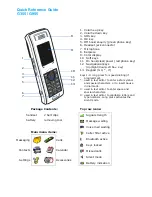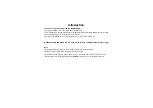
Key Concepts
449
The AppleTalk six-layer protocol suite does not fully comply with the OSI
seven-layer model. However, AppleTalk provides many of the functions
and services of OSI. AppleTalk has no specific protocols for the
Application layer because the lower levels provide printer and file service.
Physical Layer Protocols
The Physical layer of the OSI protocol stack defines the connection with
network hardware. With AppleTalk, you can use standard network
hardware, such as that designed for Ethernet and token ring networks.
Apple has also defined its own network hardware, called LocalTalk, which
uses a synchronous RS-422A bus for communications.
Link Layer Protocols
The data link layer provides the interface between the network hardware
and the upper layers of the protocol stack. The AppleTalk data link layer
includes three link access protocols (LAPs):
■
TokenTalk LAP (TLAP)
■
Ethernet LAP (ELAP)
■
LocalTalk LAP (LLAP).
The AppleTalk Address Resolution Protocol (AARP), which translates
hardware addresses to AppleTalk addresses, also exists at the data link
layer because it is closely related to the Ethernet and token ring LAPs.
AARP is usually included in the definition of each LAP, so it does not
appear in the reference model. See “AppleTalk Address Resolution
Protocol (AARP) Cache” later in this chapter for more information about
this protocol.
Network Layer Protocols
The network layer accepts data from the layers above it and divides the
data into packets to send over the network through the layers below it.
The Datagram Delivery Protocol (DDP) transfers data in packets called
datagrams
.
Datagram delivery is the basis for building other AppleTalk services such
as electronic mail. With DDP, AppleTalk runs as a process-to-process,
best-effort delivery system in which the processes running in the nodes of
interconnected networks exchange packets with each other.
Summary of Contents for CoreBuilder 3500
Page 44: ...44 CHAPTER 2 MANAGEMENT ACCESS ...
Page 58: ...58 CHAPTER 3 SYSTEM PARAMETERS ...
Page 86: ...86 CHAPTER 5 ETHERNET ...
Page 112: ...112 CHAPTER 6 FIBER DISTRIBUTED DATA INTERFACE FDDI ...
Page 208: ...208 CHAPTER 9 VIRTUAL LANS ...
Page 256: ...256 CHAPTER 10 PACKET FILTERING ...
Page 330: ...330 CHAPTER 12 VIRTUAL ROUTER REDUNDANCY PROTOCOL VRRP ...
Page 356: ...356 CHAPTER 13 IP MULTICAST ROUTING ...
Page 418: ...418 CHAPTER 14 OPEN SHORTEST PATH FIRST OSPF ...
Page 519: ...RSVP 519 Figure 94 Sample RSVP Configuration Source station End stations Routers ...
Page 566: ...566 CHAPTER 18 DEVICE MONITORING ...
Page 572: ...572 APPENDIX A TECHNICAL SUPPORT ...
Page 592: ...592 INDEX ...
















































